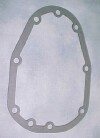hydroharry
Well-known member
- Joined
- Jul 22, 2007
- Messages
- 4,468
- displayname
- Harry Bursell
Mike - WHOA!!!! To bad about the advice from that local small engine company. At least now you've found the place for good answers to your questions. Also, I suspect you haven't down loaded the service and operators manual for your tractor. You can get those on this site as well. The Operators manual is where the fluid specs and capacities are identified, that I mentioned yesterday. To help lead you in the right direction here's a link to the Operator manual
http://ccmanuals.info/pdf/1x2-3 Operators Manual.pdfAnd here is the Service Manual
http://ccmanuals.info/pdf/1x2-3 Service Manual.pdf
And just in case you decide to follow Marty's suggestion to remove the rear cover plate to clean things out good here is the gasket you'll need (listed at CC Specialties).
http://ccmanuals.info/pdf/1x2-3 Operators Manual.pdfAnd here is the Service Manual
http://ccmanuals.info/pdf/1x2-3 Service Manual.pdf
And just in case you decide to follow Marty's suggestion to remove the rear cover plate to clean things out good here is the gasket you'll need (listed at CC Specialties).
Last edited:





















































